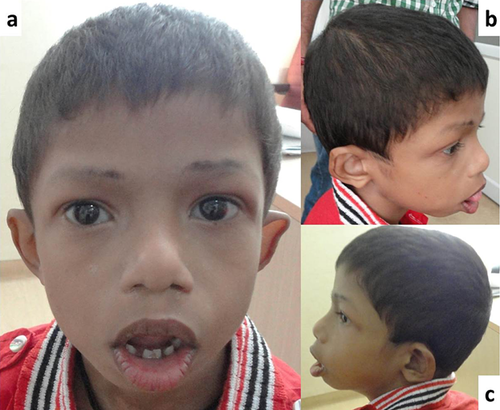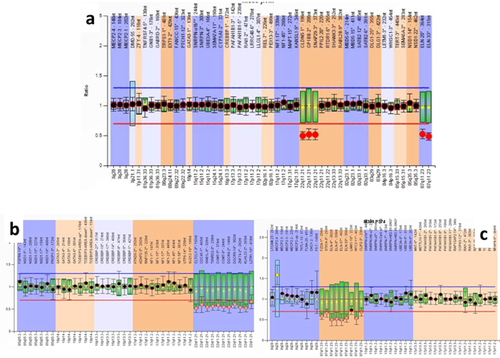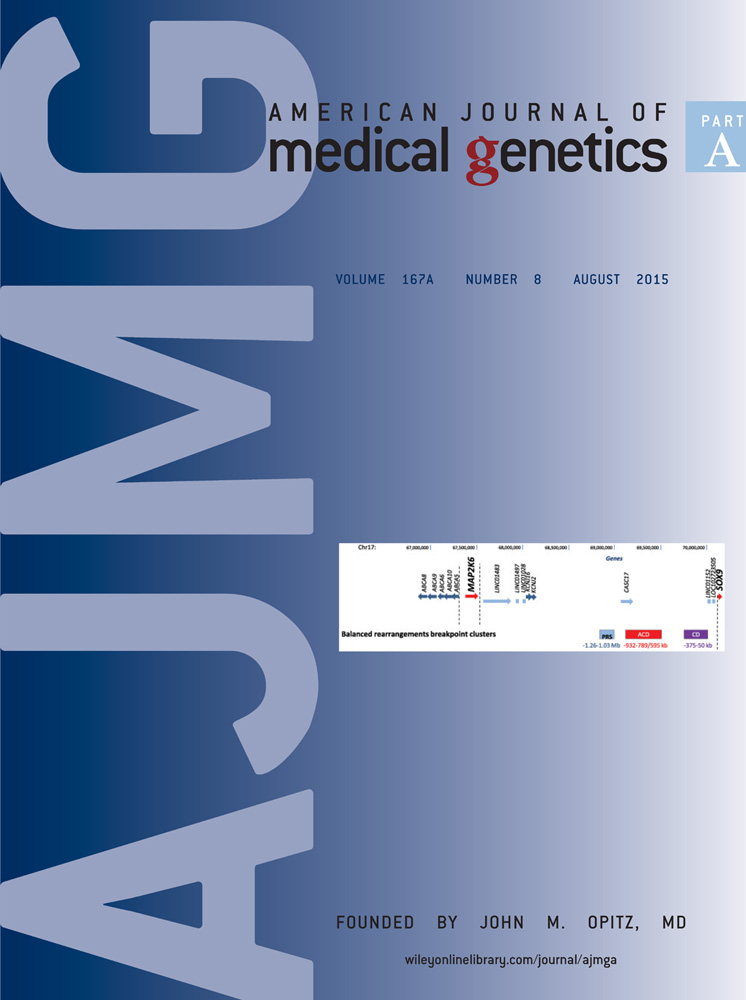Co-occurrence of a de novo Williams and 22q11.2 microdeletion syndromes
Abstract
We report on a child with de novo deletions involving the 7q11.23 (Williams syndrome) and 22q11.2 (Velocardiofacial/DiGeorge syndrome) regions. We describe the clinical features of this rare double microdeletion syndrome reported here for the first time. © 2015 Wiley Periodicals, Inc.
INTRODUCTION
DiGeorge syndrome/Velocardiofacial syndrome (DGS/VCFS, chromosome 22q11.2 deletion syndrome, OMIM 188400) and Williams Syndrome (WS, chromosome 7q11.23 deletion syndrome, OMIM 194050) are well characterized microdeletion syndromes [McDonald-McGinn et al., 1993; Morris, 1993]. DGS/VCFS is the most common microdeletion syndrome with a prevalence of 1/4,000 and is characterized by congenital heart disease, palatal abnormalities, characteristic facial features, learning disabilities, and immunodeficiency [Scambler 2000; Monteiro et al., 2013]. WS has a spectrum of cardiovascular, learning, behavioral, growth, and endocrine abnormalities [Burn, 1986; Ferrero et al., 2007]. We report on the first case of a de novo deletion in these two regions and describe the combined phenotype.
CLINICAL REPORT
This is a 6-year-old child that presented with speech delay for evaluation. He was born to non-consanguineous healthy parents and has a healthy younger sister. He was delivered at term with a birth weight of 2.2 kg (3rd centile) and head circumference of 31.8 cm (3rd centile). He had lethargy, jitteriness, and tonic seizures on second day of life. Biochemical screening showed hypocalcemia (serum calcium −6.7 mg/dl, normal levels 8.5–11.0 mg/dl) which was appropriately treated. He was readmitted to the hospital due to poor weight gain (1.9 kg at 4 weeks of life) with persistent hypocalcemia (serum calcium 6.1 mg/dl). Parathyroid hormone deficiency (iPTH −4.91 pg/ml, normal levels for all ages 15–65 pg/ml) and low 1,25 dihydroxy cholecalceferol (13.0 pg/ml, normal levels −19.6–54.3 pg/ml) were detected at 1 year. The serum calcium levels have been recorded periodically with values ranging from 3.8 mg/dl to 12.0 mg/dl at different ages. However, there is no history of seizures or any symptoms of hypocalcemia after the neonatal period. He had two episodes of lower respiratory tract infections during infancy and he underwent a left inguinal hernia repair and orchidopexy at 6 months of age. The development was markedly delayed. He attained head control at 1 year of age, rolled over at 10 months, sat at 1-year-6-months with independent walking achieved by age 3 years. He attained social smile at 6 months. He lacks verbal communication currently although he is able to communicate his basic needs non-verbally. He is yet to achieve bowel and bladder control. He did not cooperate for a formal developmental assessment.
On exam he had severe growth retardation with microcephaly. The height was 98 cm (−4 SD below the mean) and OFC, 46.5 cm (−5 SD below the mean). He had a small forehead with a low anterior hairline (Fig. 1a). The eyes were widely spaced. Strabismus and fullness of the upper eyelids were noted. The ears were low-set and protruding, the helix over-folded and indented. The superior crus of the anti-helix, the tragus, and the antitragus were underdeveloped with small ear lobe. The nasal bridge and the base of the nose were wide with hypoplastic alae nasi. The tip of the nose was bulbous with broad columella, with a smooth philtrum, thick upper and lower vermilion of the lips. The lower lip vermilion was everted. The mouth was wide and persistently open (Fig. 1a). The teeth were widely spaced. He also had microretrognathia and full cheeks. The child displayed hyperactivity, social withdrawal, aggressiveness, and self-injurious behavior. Rest of his exam was unremarkable. Echocardiography showed a normal heart. Abdomen ultrasound did not show renal or any other visceral anomalies. He was clinically diagnosed with WS and DGS/VCFS syndrome by two of his clinicians.

CYTOGENETIC AND MOLECULAR STUDIES
The child's karyotype was normal. Microdeletion testing was done by Multiplex Ligation Dependent Probe Amplification (MLPA) technique, using commercially available 6-FAM labeled probe mixes (MRC Holland, Amsterdam). Sequence type electrophoresis was done using ABI prism 310 genetic analyzer (Applied Biosystems, Foster city, CA). Fragment analysis and comparative analysis were done using Coffalyser (MRC). Probe mix P245-Microdeletion-1 (LOT0512, version B1) was used for screening for common microdeletions. A deletion was identified at 22q11.21 (all three probe sets in this probe mix for that region) and also at 7q11.23 (both of two probe sets in this probe mix for that region) suggesting co-existing DGS and WS (Fig. 2a). The 22q11.21 deletion was confirmed by Probe mix P372-Microdeletion-6 (LOT0509, version A1) (Fig. 2b), and the deletion at 7q11.23 was confirmed by Probe mix P374-Microdeletion-8 (LOT1108, version A1) (Fig. 2c). Parental screening was done by Probe mix P245-Microdeletion-1 and found to be normal for copy numbers in these regions, suggesting that both the deletions found in the child were de novo.

DISCUSSION
Both DGS/VCFS and WS syndromes are associated with characteristic facial features, variable degree of cardiac involvement, intellectual disability, and a number of other features unique to these syndromes [Ferrero et al., 2007; Cancrini et al., 2014]. The majority of the WS and approximately 90% of the DGS/VCFS are known to occur de novo. Aberrant non-allelic homologous recombinations in meiosis are thought to be the cause of these microdeletion syndromes [Saitta et al., 2004]. The present report describes the combined phenotype of these two disorders in a child due to de novo microdeletions observed in the critical regions for these syndromes. The features of these two conditions are compared with the present case in Table I.
| Features | DiGeorge syndrome | Williams syndrome | Double microdeletion |
|---|---|---|---|
| Growth | Usually normal adult height | Marked growth retardation | Severe growth retardation |
| Facial features | Unique | Unique | Mixture of both syndromes |
| Cardiovascular system | Congenital heart defect in >75%, commonly conotruncal defects | Congenital heart defect in >75%, commonly supravalvular aortic stenosis | Normal echocardiography |
| Feeding difficulty | Present | Present | Present |
| Endocrine abnormality | Hypocalcemia | Hypercalcemia | Hypocalcemia |
| Eyes | Fullnes of upper eyelids | Hyperopia and strabismus | Fullnes of upper eyelids and strabismus |
| Central nervous system | 50% have microcephaly, hypotonia, and hypocalcemic seizures | Hypotonia in infancy | Hypotonia and hypocalcemic seizures |
| Cognition | Variable motor and speech delay, upto 50% have intellectual disability | Mild intellectual disablity in most cases | Marked speech delay Severe intellectual disability |
| Behavior | Shyness or disinhibition, attention deficit, anxiety, perseveration, and difficulty with social interactions along with autism or autistic spectrum disorder | Overfriendliness, social disinhibition, excessive empathy, attention problems, and non-social anxiety | Hyperactivity, self beating, and social withdrawl |
WS is characterized by prenatal as well as postnatal growth abnormalities with failure to thrive and poor weight gain in approximately 70% cases and the final adult height is often below 5th centile [Martin et al., 2007]. On the other hand, DGS is associated with mild growth retardation but the adult height often falls in the normal range [Bassett et al., 2005]. The patient described here has growth retardation of prenatal onset.
The craniofacial features are a mixture of both syndromes in this subject. He has the typical features of full lower cheeks with malar flattening, thick and everted vermillion, and wide mouth as seen in WS [Patil et al., 2012] but the nose and ears are similar to those features seen in DGS/VCFS. The fullness of the upper eyelids too resembles that of DGS/VCFS [McDonald-McGinn et al., 1993].The behavioral phenotype of hyperactivity, irritability with a low level of useful activity and increased emotionality is a common feature to both of these syndromes. But social withdrawal/shyness is the characteristic feature of DGS/VCFS whereas those with WS have socially disinhibited behavior [Schonherz et al., 2014]. The behavior resembled that of DGS/VCFS more than WS. Our patient lacked the usual friendliness of WS.
DGS/VCFS is known to be associated with major congenital heart defects like tetralogy of Fallot, truncus arteriosus, and other outflow tract anomalies. WS often has stenotic supravalvar lesions (involving aorta and peripheral pulmonary artery). Surprisingly, though congenital heart defect is a major feature of both these syndromes, there was no evidence of any structural heart defect.
The persistent hypocalcemia could be attributed to the hypoparathyroidism observed in DGS. Persistent hypocalcemia occurs in up to 60% of individuals and is most severe in the neonatal period but known to improve with age [Weinzimer 2001]. Hypercalcemia of unknown etiology can be present in up to 50% of individuals with WS along with hypothyroidism and impaired glucose tolerance.
Feeding difficulties are a feature of both of these microdeletion syndromes. In WS, it is attributable to the poor suck, swallow, and gastro-esophageal reflux while in DGS/VCFS, dysmotility in the pharyngo-esophageal area is the major cause. It may also lead to episodes of recurrent pneumonias in children. He had inguinal hernia and undescended testis (unilateral/left sided). Though inguinal hernia can be seen in both DGS/VCFS as well as WS, undescended testis has been observed in DGS/VCFS only.
The case appears to represent a chance occurrence of two microdeletions. It gives a depiction of the unique phenotype with overlapping features, and also lack of abnormalities commonly expected in both these disorders like cardiac defects.
ACKNOWLEDGMENTS
The authors are grateful to the child and his family for their kind cooperation in this study. The authors are grateful to Indian Council of Medical Research for the financial support.




